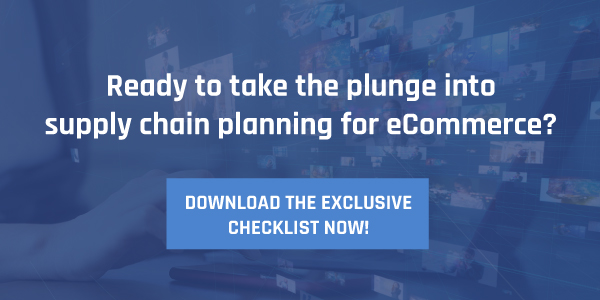
Why Supply Chain Management is Fundamental to eCommerce
July 13, 2021
Top 10 Successful eCommerce Companies Using Effective Supply Chain Management
July 26, 2021What does it take to make the pivot to eCommerce? While you may have honed your supply chain management skills in the brick & mortar arena, that doesn’t mean they’ll translate effortlessly to digital. The reality is, eCommerce is a brand new dimension of supply chain management. It operates by different rules, and it takes some time to level up your skills to make the transition.
As a Demand Driven methodology expert, Patrick Rigoni is uniquely positioned to guide clients towards optimization and efficiency in eCommerce. This primer is intended to run down the basics of eCommerce for supply chain managers, with a focus on a few key tips and strategies.
What is eCommerce?
You’ve heard about it, read about it, what exactly is eCommerce? Let’s make sure we’re all on the same page about one of 2021’s hottest supply chain trends.
eCommerce (short for electronic commerce) describes the buying and selling of products online, along with the exchange of data and finances that’s inherent to it. While it usually involves physical items for sale on the Internet, eCommerce can also refer to other types of commercial transactions that occur online.
All types of business dynamics fit into the eCommerce framework: B2B (business to business), B2C (business to customer), C2C (consumer to consumer), and C2B (consumer to business). Dropshipping, retail, wholesale, services, digital productions, and subscriptions can all take place via online-only purchasing platforms.
Although eCommerce began in a rudimentary form in the early 1990s, online purchases have spiked over the last 5-10 years. eCommerce makes up a large slice of the global economic pie these days, topping more than $4 trillion in sales worldwide in 2020.
Key Terms
- Brick & Mortar – refers to commerce that involves a physical retail location where shoppers can search for products and purchase them on-the-spot. The traditional model.
- FC – A fulfillment center, sometimes called a distribution center (DC) is a warehouse where products are stored and shipped out to customers. The allocation of FCs is crucial to eCommerce supply chain strategy. In general, having multiple FCs and placing them as close to customers as possible is key.
- Order-to-Deliver – No metric better tells the story of the eCommerce customer experience than this one. It’s one of several metrics that are more heavily weighted in eCommerce compared to the traditional supply chain model.
- Order-Generation – Another eCommerce-specific data point. This metric refers to the time it takes for an online order to reach the fulfillment center that will go on to distribute it.
- WISMO & WISMR – Stands for “Where is my order?” and “Where is my return?” These acronyms are also key customer experience metrics you’ll want to keep tabs on as an eCommerce supply chain manager.
- Holding Risk – This refers to the cost of keeping inventory in stock when it’s not selling.
- Stockout Risk – On the other end of the spectrum, this term involves the money lost when there’s a shortage in supply and concurrent demand for an item. Ideally, eCommerce supply chain managers find a balance between both holding risk and stockout risk.
Focus on Customer Experience
It may be clear at this point that customer experience has a significant impact on supply chain management for eCommerce, and vice versa. That’s because the customer touchpoints along the digital supply chain are simply more prevalent than the brick and mortar type.

After a consumer hits “order,” they expect transparency and communication along each step of the chain. That means tracking and status updates, and a precise delivery estimate. Customers interact directly with the carrier when delivery occurs and if returns are needed.
Fast & free shipping is the norm in this space, as are free returns. It’s important to optimize FCs so that they are located as close to customers as possible, cutting down on both time and cost to fulfill orders.
Packaging is also worth some thought. Some businesses opt for no-frills wrapping while others choose to make the packaging experiential, investing in high quality materials and tailor-made design. It’s a personal choice, dependent on the sector, product type, and target demographic. As supply chain manager, you’ll make the call on whether it’s wisest to allocate financial resources here or shuffle them elsewhere and reap the savings.
Selecting a Fulfillment Partner
This one requires some research. You’ll want to investigate and compare estimates from a variety of third-party logistics managers (3PLs) to find the best fit for your business.
Consider fulfillment partners that specialize in eCommerce, as they’ll be familiar with the ins and outs of this particular business model and its digital roots. Beyond that, look for 3PLs that know your sector, whether that’s health/wellness, pharmaceuticals, or machinery. When everyone’s speaking the same language, it’s easier to get business done efficiently.
Do You Have What it Takes?
If you think you’re ready to navigate the eCommerce supply chain, make sure you’re armed with all the tools to succeed. Patrick Rigoni has compiled an exclusive checklist for supply chain management within eCommerce, packed with insight and advice. The guide explores a wealth of topics in-depth, all in a checklist format that breaks down complex material into actionable steps.
Ready to make the leap? You’re invited to download your copy of the eCommerce Checklist for supply chain managers to launch your digital strategy today!





